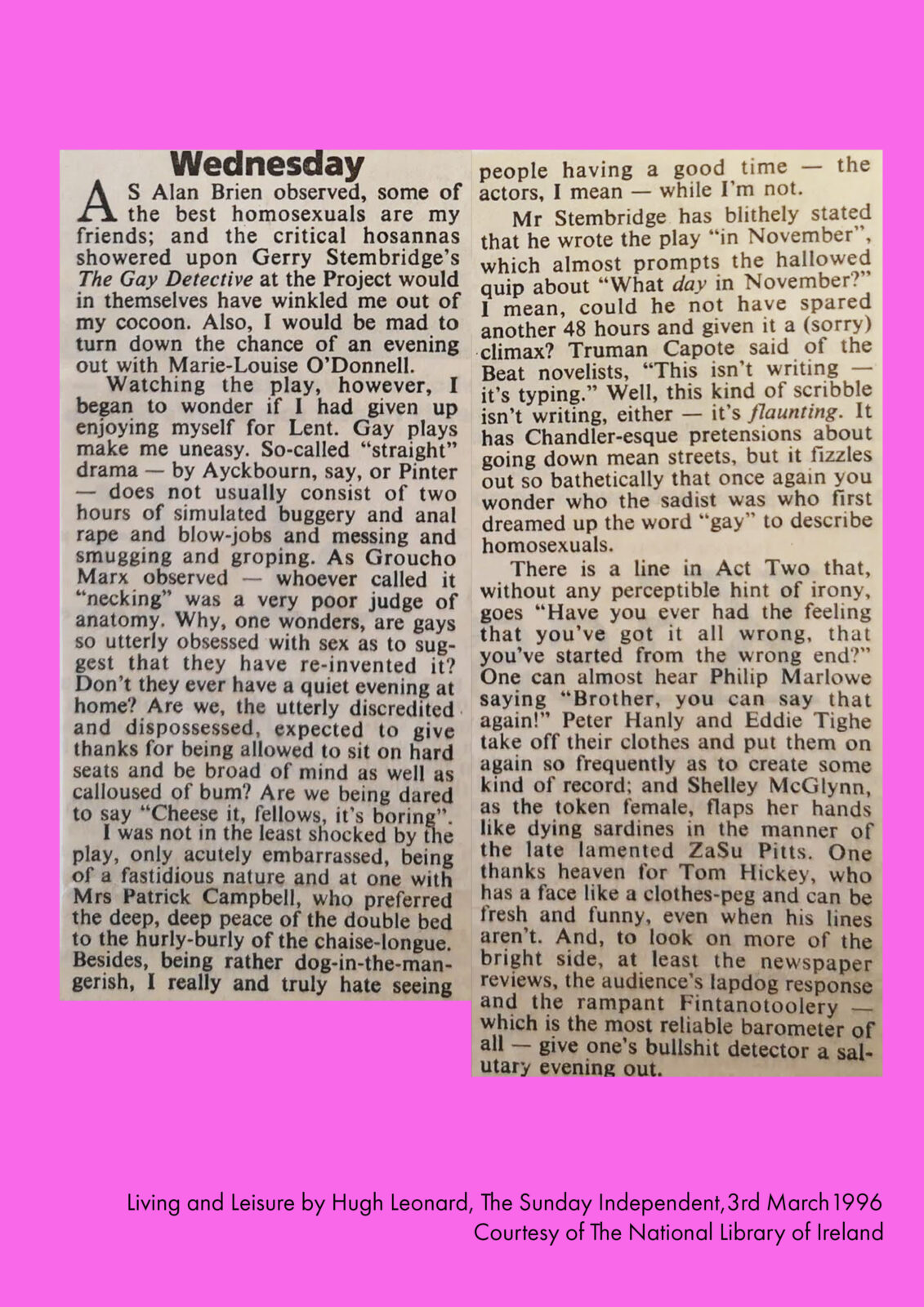Active Archive
In 1996, The Gay Detective by Gerard Stembridge undertook to depict the everyday challenges of gay life in a realistic fashion, avoiding stereotypes and cliches. Reviewers opinions were mixed as to whether or not Stembridge achieved this. David Nowlan suggested ‘…it goes a great distance towards normalising a normal sexual orientation that too many societies have perceived as an abnormal deviance’.[1] Fintan O’Toole echoed, ‘The play is emphatically not about male homosexuality, in that it treats the state of being gay as in itself perfectly normal and morally neutral.[2] However, playwright Hugh Leonard scathingly, and admittedly with some bias, wrote, ‘Watching the play,… I began to wonder if I had given up enjoying myself for Lent. Gay plays make me uneasy. So-called “ straight” drama… does not usually consist of two hours of simulated buggery and anal rape and blowjobs and messing and smugging and groping’.[3]
The Gay Detective in question is the character of Pat, a gay Garda Sergeant who gets promoted to plain-clothes detective in order to investigate a high profile murder at a gay sauna. The plot plays out as a crime story revealing the highs and lows of the homosexual underworld that Pat infiltrates. The threat of Pat’s sexuality is used by his superior as a means of control; challenging him to reign in his sexual proclivity in order to gain the promotion. Set on the eve of decriminalisation, Pat sits within a precarious standpoint, that of law holder and lawbreaker. As a Guard, he is responsible for enforcing a law; the very law that he himself, as a gay man, is in breach of. Kathleen Heininge identifies how this position ‘…would seem to be an anomaly at any other given time in history. At the moment of change, however, he becomes the symbol of… what may become a new class consciousness’.[4]
The idea of ‘class consciousness’ is played out in the final scenes of the play. After being informed by his superior that there will never be an investigation into the queer-bashing that he has uncovered, Pat realises that he has been manipulated. In frustration, he walks out on the investigation to be with his dying friend. An act which Heininge suggests as: ‘…rejecting the paradigms of either Detective or Gay, but adopting one belonging to all of humanity – best friend’.[4] Fintan O’Toole encapsulates the importance of this narrative by suggesting that: ‘the play… simply use[s] gay subculture as a mirror for Irish Society. Seeing it reversed in that mirror, you pay more attention to the writing on the wall.[2]
(Text adapted from “Foul, Filthy, Stinking Muck”: The LGBT Theatre of Project Arts Centre, 1966 to 2000 by Hannah Tiernan, 2019)
 [1] David Nowlan, Freshness without sentiment. The Irish Times, 10 February 1996
[1] David Nowlan, Freshness without sentiment. The Irish Times, 10 February 1996
[2] Fintan O’Toole, From gaiety into darkness. The Irish Times, 20 February 1996
[3] Hugh Leonard, Living and Leisure. The Sunday Independent, 3 March 1996
[4] Kathleen A. Heininge (2009). Living by the Code: Authority in The Gay Detective. In: Cregan, D., ed. Deviant Acts: Essays on Queer Performance. Dublin: Carysfort Press, 191
